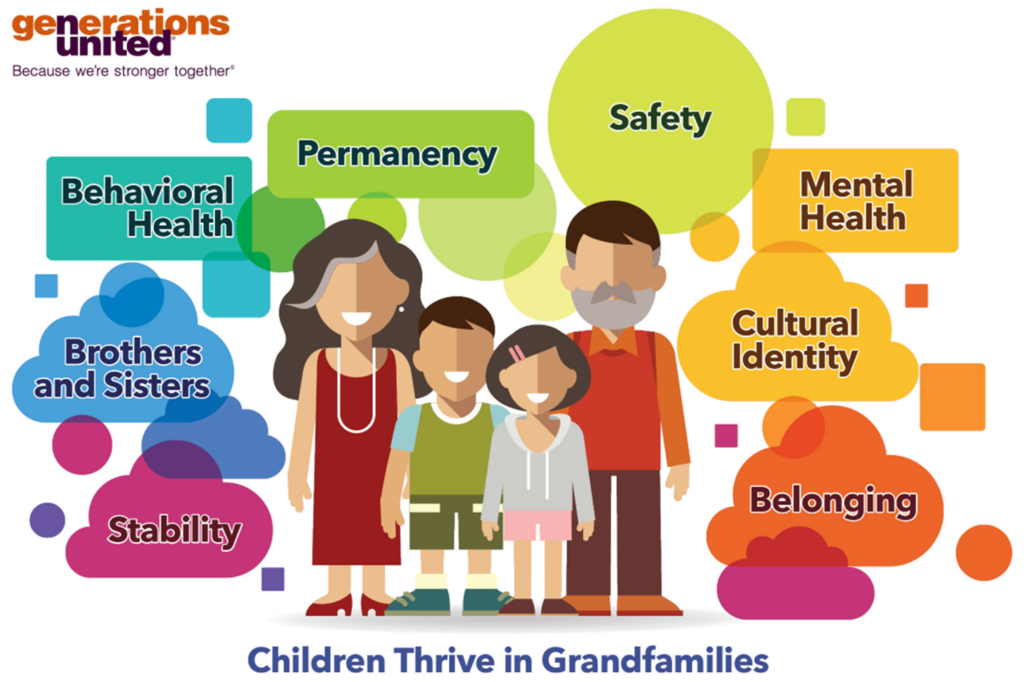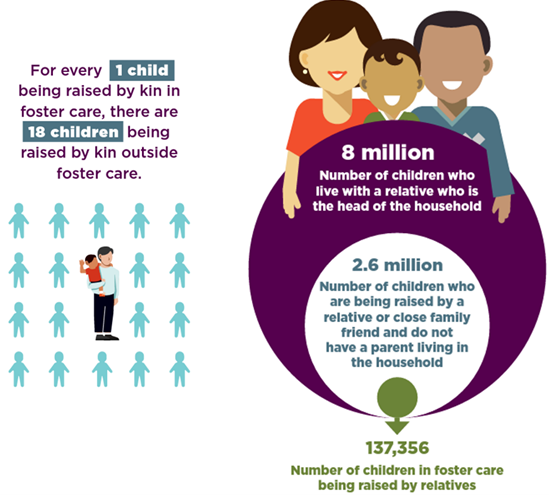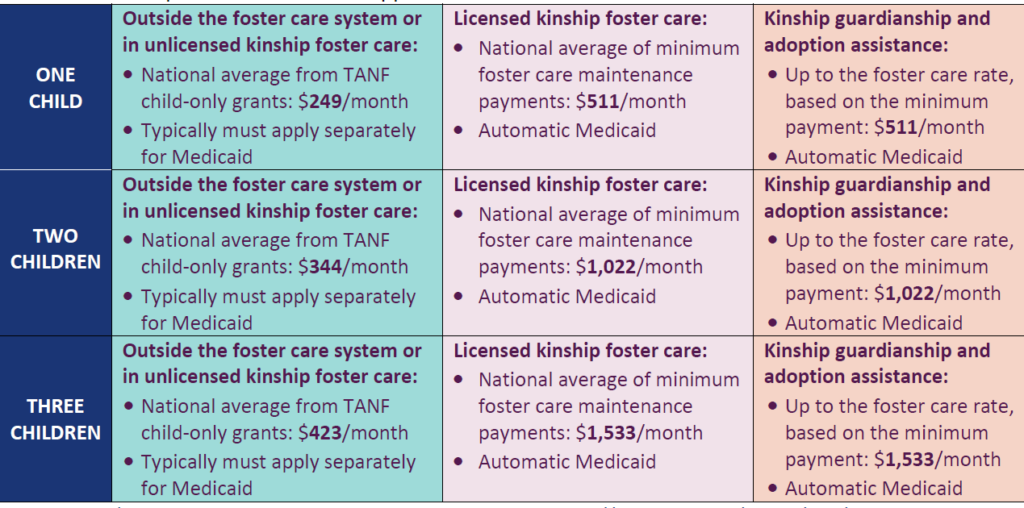Strengths & Challenges

What are the strengths and challenges of kinship/grandfamilies?
Imagine you are a child. In the middle of the night, your mom drops you off at your grandma’s house to live. Your mom and dad can’t care for you anymore. Their opioid and alcohol use have made it impossible to parent. You’re glad to be with your grandma because it feels safe and comfortable at her house, but you’re worried about some things. Where will you go to school? How will you get your asthma medicine? Can your grandma get it for you? Will your mom and dad be okay?
Parental substance use is just one of the many reasons grandfamilies and kinship families come together. Grandfamilies and kinship families are families in which children reside with and are being raised by grandparents, other relatives, or other adults with whom they have a close family-like relationship (such as godparents or family friends). Other reasons grandfamilies and kinship families form include parental military deployment, incarceration, mental or physical illness, and death. Whatever the cause, when parents are unable to care for their children, these caregivers often step in at a moment’s notice to keep families together.

Grandfamilies and kinship families have unique strengths and face unique challenges. Unlike parents, these caregivers do not have inherent legal rights and responsibilities with respect to the children they raise. They often take informal responsibility for children suddenly and have no time to plan for financial, housing, or other needs.
HOW MANY CHILDREN LIVE IN GRANDFAMILIES AND KINSHIP FAMILIES?
- Over 2.6 million children are being raised by a grandparent, other relative, or close family friend and do not have a parent living in the household. 1
- There are 137,356 children who are in the legal custody of the child welfare system with relatives providing the care. These children represent over one-third of all children in foster care. 2
- The percentage of children in foster care with relatives increased from 26% in 2010 to 34% in 2020. 3
- For every one child in the foster care system with a relative providing the care, there are 18 children being raised by relatives outside that system. 4

WHAT DO AVAILABLE DATA SHOW ABOUT THESE GRANDFAMILIES AND KINSHIP FAMILIES?
While grandfamilies and kinship families include families where grandparents, other relatives, or close family friends are caregivers, most of the demographic data available are about families in which grandparents are the householders and are responsible for their grandchildren. Over 2.4 million grandparents are responsible for their grandchildren. 5
The data show that these millions of grandfamilies and kinship families span the racial, ethnic, socioeconomic, and geographic spectrum.
Grandfamilies and kinship families are racially and ethnically diverse
- About 54% of children whose grandparents are responsible for them are white, 25% are Black or African American, 2.2% are American Indian or Alaska Native, 1.6% are Asian, 0.4% are Native Hawaiian or Pacific Islander, and 23.8% are Latino or Hispanic. 6
- About 64% of grandparents responsible for their grandchildren are white, 20% are Black or African American, 2.2% are American Indian or Alaska Native, 3.6% are Asian, 0.3% are Native Hawaiian or Pacific Islander, and 19.5% are Latino or Hispanic. 7
- Because of the diversity of the families, programs and policies need to be culturally sensitive, written materials may be needed in two or more languages, and multilingual staff might be essential.
Children in grandfamilies and kinship families are more likely to be poor than children in other families
- About 30% of children whose grandparents are responsible for them and who have no parent in the home are living in poverty, as compared to 18% of children in the general population. 8
- In 2012, 48% of children who lived with a grandmother only and had no parents in the home lived in poverty. Due to historical and current inequities, a disproportionate percentage, 42%, of these children were Black. 9
- Approximately 18% of all grandparent householders responsible for their grandchildren are living in poverty. 10
- Without the time to plan for children they did not expect to raise, grandfamily and kin caregivers typically need additional financial resources to meet the children’s needs.
Members of grandfamilies and kinship families are all ages
- Approximately 37% of children living with grandparents who are responsible for them are under 6 years old, nearly 34% are between the ages of 6 and 11, and nearly 29% are between ages 12 and 17. 11
- Over 45% of all grandparents responsible for their grandchildren are age 60 and older, and about 54% are between ages 30 and 59. 12
- Policies and program to support grandfamilies and kinship families should be designed to serve families of all ages.
Most grandparent caregivers are in the labor force
- Nearly 56% of grandparents responsible for their grandchildren are in the labor force. 13
- Since most caregivers are age 60 and under and still in the work force, childcare and before- and after-school activities are programs that need to be considered for these families.
Grandparent caregivers are more likely than parents to have a disability
- Nearly 25% of grandparents responsible for their grandchildren have a disability, compared to about 10% of parents of children under age 18. 14
- Kinship navigator programs play a critical role in providing information on the range of services that may be available to grandfamilies and kinship families; these programs should keep in mind the large number of grandparent caregivers with disabilities when serving the families.
Grandparents and the grandchildren they raise live together for a long time
- Over 61% of grandparents responsible for their grandchildren raised them for at least three years, and more than 45% have raised their grandchildren for five or more years.15
- Because it is a long relationship, stable housing, educational access, and other services must be developed and delivered for grandfamilies.
Most grandfamily and kin caregivers own their home
- Although about 60% of grandparents and other relatives raising children own their home, they still face challenges. 16 Caregivers’ homes may not be big enough or well-maintained enough to accommodate children, or they may not be child-proofed.
- Less than one-third of income-eligible grandfamilies and kinship families receive housing assistance. 17
- Policymakers should ensure that housing programs are available to grandfamilies and kinship families to do home repairs and modifications and to add bedrooms and bathrooms at an affordable cost. 18
WHAT DOES THE RESEARCH SHOW ABOUT GRANDFAMILIES’ STRENGTHS?
Decades of research repeatedly confirm that children who cannot remain with their parents thrive when raised by relatives and close family friends.
Children in foster care with relatives have more stable and safe childhoods than children in foster care with non-relatives, with a greater likelihood of a having a permanent home. They experience fewer school changes, have better behavioral and mental health outcomes, and report that they “always felt loved.” They keep their connections to their siblings, their family and community, and their cultural identity. Moreover, children in foster care with relatives are less likely to re-enter the foster care system after returning to their birth parents. If returning to their parents is not possible, relatives tend to be willing to adopt or become permanent guardians. About 35% of all children adopted from foster care are adopted by relatives, and 10% of children who exit foster care exit into guardianships. 19
On top of the many benefits to children, caregivers report benefiting from their role, often citing an increased sense of purpose. Birth parents may also value that their children remain connected to family and friends. 20
“We have friends who are retired who are always telling me about their next cruise to Hawaii. I tell them I go on cruises every day. I cruise to school, I cruise to the doctor’s office, I cruise to the skateboarding park. Joey is my ‘cruise to Hawaii’ and you know what, I wouldn’t trade my cruise for theirs.
-Adrian Charniak, GRAND Voice caregiver advocate, Illinois
WHAT CHALLENGES DO GRANDFAMILIES AND KINSHIP FAMILIES FACE?
Over the past twenty years, available data and research have helped uncover the challenges faced by grandfamilies and kinship families, as well as their strengths. Generations United and its many partners have collectively made great strides, but important work remains to be done.
Legal
Legal issues are frequently among the top concerns for grandfamilies and kinship families:
- Unlike parents, grandfamily and kin caregivers do not have legal rights and responsibilities with respect to the children they raise unless they either go to court, receive a power of attorney from the parents, or complete an educational and health care consent affidavit (if their jurisdiction has one).
- The process of obtaining a legal relationship with the children – such as adoption, legal custody, or guardianship – is usually expensive and time-consuming and can be disruptive to family dynamics.
- Opting to raise the children without any legal relationship may severely limit caregivers’ ability to access services on the children’s behalf, but getting legal assistance through private attorneys may be unaffordable, and other legal resources – such as legal aid and law school clinics – may be unknown.
- Kinship navigator programs help link caregivers with legal resources, but many states, territories, and tribes do not have comprehensive programs yet. Federal funds are available for these programs through the Children’s Bureau in the Administration for Children, Youth and Families.
- In 2008, the Fostering Connections to Success and Increasing Adoptions Act gave states, territories, and tribes the option to use federal child welfare funds (Title IV-E of the Social Security Act) for guardianship assistance programs that allow eligible children to exit the foster care system to guardianship with a licensed relative. About 10 states still need to act on the opportunity to provide children with this permanency option. 21
- Creative legal options, e.g., standby guardianship laws and de facto custody laws, do not exist in all states.
- Many states lack educational and health care consent or authorization laws, which allow caregivers who do not have a legal relationship to the children to enroll the children in school and access necessary health care on their behalf. 22
Financial
Having additional children in the household typically requires additional income or resources, but available ongoing assistance to help meet these children’s needs is woefully inadequate and inequitable:
- Children in foster care with unrelated caregivers receive monthly foster care maintenance payments, but most children in foster care with grandfamily or kin caregivers do not receive these payments. According to analysts at the Chronicle of Social Change, over 108,400 children who are being raised by grandfamily or kin caregivers while in the legal custody of a child welfare agency do not receive a foster care payment. 23
- Children in the care of grandfamily or kin caregivers are often referred to child-only Temporary Assistance for Needy Families (TANF) grants as the only source of ongoing financial support. There are many access issues in getting these grants, and they are typically much smaller than foster care maintenance payments and only rise incrementally for each child.
- Children may receive Social Security survivor or disability benefits, but that can prevent them from receiving TANF and other public benefits.

Physical and Mental Health
Both the caregivers and the children in these families face physical and mental health issues to a greater degree than the general population:
- Children being raised by grandparents exhibit a variety of physical, behavioral, and emotional problems to a greater degree than the general population of children, often due to the difficult situations that caused them to be placed in their grandparent’s care.25
- Grandfamily and kin caregivers are often socially isolated from their peers and may feel guilt and shame about their adult relative or friend who is unable to parent, especially if it is their child.
- Grandfamily and kin caregivers may be experiencing grief related to the loss of the child’s parent, the change in their expectations for their lives (e.g., retirement), or the loss of the cherished role of a traditional grandparent, aunt/uncle, cousin, friend, etc.
- Grandfamily and kin caregivers are frequently unable to attend to their own health care needs due to a lack of daycare, respite care, and/or adequate health care insurance.
- Supportive services – such as caregiver support groups, respite, and counseling – help the families cope with their physical and mental health issues, but these services may be unavailable. The National Family Caregiver Support Program funds Area Agencies on Aging (AAAs) to help grandfamily and other family caregivers aged 55 and older, but some AAAs opt not to serve them.
“Growing up with a childhood full of trauma and abuse, there were very few moments where I felt safe and very few people with whom I felt protected. Being put into my uncle’s care was the best decision that could have ever been made for me. It wasn’t an easy road by any means, but I have no doubt in that it completely saved my life.”
– Kindra, raised by her uncle, California
Housing
Grandfamily and kin caregivers often begin caring for children without warning or preparation, and they face unique problems with respect to housing:
- Many grandfamily and kin caregivers live in small apartments and houses that are not suitable for children.
- With the extra expenses of raising children, caregivers may no longer be able to afford their housing.
- Caregivers living in public senior housing with children may be wrongfully evicted because of the children.
- The presence of children may violate private lease agreements.
- If caregivers do not have legal custody of the children, they are often unable to convince the housing authorities to recognize their need for larger apartments.
Education
Many school policies are geared towards “nuclear” families and can pose obstacles for grandfamilies and kinship families, especially those families in which there are no legal ties:
- Children may be denied school enrollment if their grandfamily or kin caregivers do not have guardianship or legal custody.
- Contrary to the federal Individuals with Disabilities Education Act, grandparents and other relatives or close family friends acting as parents may have difficulty being included as participants in the Individual Education Plan (IEP) process for children with disabilities.
CONCLUSION
Policies and programs at the federal, state, and local levels should encourage, rather than discourage, the responsible actions of grandfamily and kin caregivers who step forward to take care of children who cannot be raised by their parents. Public awareness through community education and media outreach is an integral part of any effort to support these families. As an aid towards improving public knowledge about grandfamilies, the Grandfamilies & Kinship Support Network, the first national technical assistance center on grandfamilies and kinship families, built and run through a cooperative agreement with the Administration for Community Living, has updated this long-standing resource of Generations United. You are welcome to link to this resource, download it, freely distribute it, and use it.
ADDITIONAL RESOURCES
www.gu.org – Resources and publications on grandfamilies, including Generations United’s annual State of Grandfamilies reports
www.grandfamilies.org – A comprehensive one-stop national website for publications, materials, and laws impacting grandfamilies both inside and outside the foster care system in all 50 states and the District of Columbia
www.grandfactsheets.org – Fact sheets for each state and the District of Columbia containing specific state information related to grandfamilies, including a comprehensive list of resources and services
A previous version of this fact sheet was funded by The Brookdale Foundation Group. We thank them for their support and acknowledge that the ideas, findings, and conclusions presented in this fact sheet are those of Generations United alone and do not necessarily reflect the opinions of The Brookdale Foundation Group. The Grandfamilies & Kinship Support Network at Generations United is pleased to be able to offer this updated version of the fact sheet.
Footnotes
-
Annie E. Casey Foundation Kids Count Data Center. 2019-2021. “Children in kinship care in the United States.” Accessed March 2022. https://datacenter.kidscount.org/data/tables/10455-children-in-kinship-care?loc=1&loct=2#detailed/1/any/false/2097/any/20160,20161
-
U.S. Department of Health and Human Services, Administration for Children and Families, Administration on Children, Youth and Families, Children’s Bureau. 2021. “The AFCARS report, Preliminary FY 2020 Estimates (No. 28).” Accessed March 2022. https://www.acf.hhs.gov/sites/default/files/documents/cb/afcarsreport28.pdf. Please note that there are limitations with AFCARS data and children in relative foster care may be underrepresented. In some states, children must receive foster care maintenance payments to be counted, and most children living with relatives do not receive this assistance. Some states do not distinguish between licensed relative foster parents and non-related licensed foster parents.
-
U.S. Department of Health and Human Services, Administration for Children and Families, Administration on Children, Youth and Families, Children’s Bureau. 2011. “The AFCARS report, Preliminary FY 2008 Estimates (No. 18).” Accessed March 2022. https://www.acf.hhs.gov/cb/report/afcars-report-18; and “The AFCARS report, Preliminary FY 2018 Estimates (No. 28).” Accessed March 2022. https://www.acf.hhs.gov/sites/default/files/documents/cb/afcarsreport28.pdf
-
Generations United. 2021. State of Grandfamilies Report 2021, Reinforcing a Strong Foundation: Equitable supports for basic needs of grandfamilies. Accessed March 2022. . https://www.gu.org/app/uploads/2022/02/2021-Grandfamilies-Report_V14.pdf
-
U.S. Census Bureau. “Table S1002 – Grandparents, 2020 American Community Survey 5-Year Estimates.” Accessed March 2022. https://data.census.gov/cedsci/table?q=S1002%3A%20GRANDPARENTS&tid=ACSST5Y2020.S1002
-
U.S. Census Bureau. “Table S1001 – Grandchildren Characteristics, 2020 American Community Survey 5-Year Estimates.” Accessed March 2022. https://data.census.gov/cedsci/table?q=S1001&tid=ACSST5Y2020.S1001 Similar data are not publicly available for other relatives and family friends.
-
See endnote 5.
-
See endnote 4.
-
Ibid.
-
See endnote 5.
-
See endnote 6.
-
See endnote 5.
-
Ibid.
-
Ibid.; and National Research Center for Parents with Disabilities. 2018. “Parents With and Without Disabilities: Demographics, Material Hardship, and Program Participation.” Accessed April 2022. https://heller.brandeis.edu/parents-with-disabilities/data-hub/additional-resources/parents-with-without-disabilities.html
-
U.S. Census Bureau. “Table B10050 – Grandparents Living with Own Grandchildren Under 18 Years by Responsibility for Own Grandchildren by Length of Time Responsible for Own Grandchildren for the Population 30 Years and Over, 2020 American Community Survey 5-Year Estimates.” Accessed April 2022. https://data.census.gov/cedsci/table?q=B10050%3A%20GRANDPARENTS%20LIVING%20WITH%20OWN%20GRANDCHILDREN%20UNDER%2018%20YEARS%20BY%20RESPONSIBILITY%20FOR%20OWN%20GRANDCHILDREN%20BY%20LENGTH%20OF%20TIME%20RESPONSIBLE%20FOR%20OWN%20GRANDCHILDREN%20FOR%20THE%20POPULATION%2030%20YEARS%20AND%20OVER&tid=ACSDT5Y2020.B10050 Similar data not publicly available for other relatives and family friends.
-
Generations United. 2019. State of Grandfamilies Report, A Place to Call Home: Building affordable housing for grandfamilies. Accessed April 2022. https://www.gu.org/app/uploads/2019/11/19-Grandfamilies-Report-APlacetoCallHome.pdf
-
Ibid.
-
Ibid.
-
See endnote 2.
-
Hartwell-Walker, Marie. 2015. “Challenges and Benefits for Grandparent Caregivers.” Psych Central. Accessed February 2020. http://psychcentral.com/lib/challenges-and-benefits-for-grandparent-caregivers
-
ABA Center on Children and the Law, Casey Family Programs, Children’s Defense Fund and Generations United. 2019. “Leveraging the Family First Prevention Services Act to Improve the Use of Title IV-E GAP. Accessed February 2020. www.grandfamilies.org/Portals/0/Documents/FFPSA/Title%20IV-E%20GAP%20Brief.pdf; and U.S. Department of Health and Human Services, Administration for Children and Families, Administration on Children, Youth and Families, Children’s Bureau. 2013 (Current as of July 1, 2021). “Title IV-E Guardianship Assistance.” Accessed April 2022. https://www.acf.hhs.gov/cb/grant-funding/title-iv-e-guardianship-assistance
-
Ana Beltran, Policy Brief: State Educational and Health Care Consent Laws: Ensure that children in grandfamilies can access fundamental services (Washington, DC: Generations United, 2013), accessed May 2, 2022, https://www.grandfamilies.org/Portals/0/Documents/Education/GU%20Policy%20Brief%20October%202014.pdf.
-
The Chronicle of Social Change. 2019. “Fewer Foster Youth, More Foster Homes: Findings from the 2019 Who Cares Project.” Accessed February 2020. https://chronicleofsocialchange.org/featured/less-foster-youth-more-foster-homes-findings-from-the-2019-who-cares-project/38197.
-
U.S. Government Accountability Office. 2011. “TANF AND CHILD WELFARE PROGRAMS: Increased Data Sharing Could Improve Access to Benefits and Services” Accessed March 2020. www.gao.gov/assets/590/585649.pdf. For more information on adoption assistance, see www.nacac.org/help/adoption-assistance/; and for more information on guardianship assistance, see http://www.grandfamilies.org/Portals/0/Documents/Fostering%20Connections/Making%20it%20Work%20-%20GAP%20report%202012.pdf
-
Altshuler, S.J. 1998. Child Well-Being in Kinship Foster Care: Similar To, or Different From, Non-Related Foster Care, Children and Youth Services Review 20, 369-88, and Pruchno, R. 1999. Raising Grandchildren: The Experiences of Black and White Grandmothers, The Gerontologist 39, 209-31.